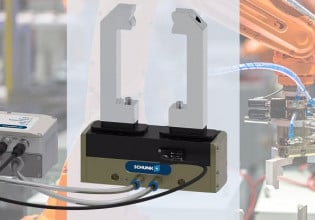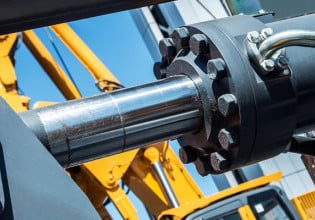Trading Customization for Flexibility: Roundup of Robot Gripper Ecosystems
A recently common term applied to systems of standardized robot grippers is an ‘ecosystem,’ but what does this actually mean, and what are some examples of implementation in manufacturing industries?
Usually, we hear the term ‘ecosystem’ applied to a scenic mountain meadow or a tropical wetland while describing the dependence of one species upon another for survival. In essence, they all live together in harmony, creating balance and a perfect habitation environment for good things to grow and thrive.
As we apply this term to technology, the biology aspect is removed, but the sense of unity and harmony is retained. We wish to create an environment where one component is added or replaced by another with as little discomfort or burden to the rest of the system as possible.
One of the recent trends in this ‘ecosystem’ concept is in the field of robotic grippers, where the need for flexibility and agility sometimes overrides the desire for strong, robust components.

Modifying, changing, and adjusting end tools can be difficult when the only options are highly customized devices. Image used courtesy of Adobe Stock
What Is a Gripper Ecosystem?
Every robot relies on some sort of end-of-arm effector (EoAT) to accomplish its task. The EoAT is what gives a robot the ability to manipulate objects and move products from one point to another and relieve human operators of back-breaking or hazardous work. Without this, it’s simply a stub of an arm rotating in space.
In the early days of industrial robotics, these heavy, high-speed devices used a single attachment for a devoted purpose. To move an object, weld a pipe fitting, or set a bead of adhesive. But as robotic technology advanced, so did the ability of a robot to complete two, three, or even more tasks—essentially a multitasking computer.
The problem is that multitasking cannot be accomplished with just one end tool. Imagine cooking. You need to stir a sauce, drain the noodles, and chop the onions, all within minutes to create the perfect dish (I’m getting hungry now, thanks). Those tasks must be done with separate tools. The same can be said for robots. For a robot to achieve maximum running time, it must handle multiple end tools with multiple parts to achieve the best and fastest ROI possible.
The gripper ecosystem is an extensive set of tools, all easy to install and remove, which can help the robot accomplish multiple tasks and require as little input from the programmer and engineer as possible.
What Ecosystem Options Are Available?
Several examples exist of companies that have taken the passion and design for end effectors to the next step: making them so easy to interchange that flexibility is nearly infinite. There is a bit of a problem with interchangeability, though. What if one gripper requires air power, and another requires servo signals? What if one uses IO-Link while another is discrete I/O? An experienced engineer may be able to address these problems, but for most companies, the solution must be made simpler.
Universal Robots UR+ Ecosystem
One of the leading companies in the origin of collaborative robotics, Universal Robots (UR), has developed the UR+ ecosystem, relying on various partners to develop end tools—and sometimes entire work cells—that integrate with a UR controller.
These UR+ applications may be as simple as a 2-jaw gripper or as complex as an entire welding enclosure and work table, all with software that incorporates directly into a simple interface for the programmer.

An example of the UR+ ecosystem in the form of the MiniPAL palletizer from Columbia/Okura. Image used courtesy of UR and Columbia/Okura
Some robotic companies prefer a quick-change system, where one single adapter plate mounts to the robot while the various end tools connect to the plate, identifying their I/O features for a rapid connection to the controller.
Schmalz and Zimmer: MATCH End-of-Arm Ecosystem
One such example of this system is the MATCH end tool catalog from Schmalz in partnership with Zimmer. Tools from vacuums to jaws to magnetics are all readily available and interchangeable with a quick button press.
Only a small standardized base plate is fixed to the end of the robot arm. When a new tool is connected to the base plate, it automatically identifies the tool type, limits, and signal requirements, automatically updating it in the program for simple, quick tool changes.

The MATCH system from Zimmer and Schmalz allows simple interchange of a wide variety of end tools. Image used courtesy of Zimmer Group
Destaco Tool Changer
Similarly, the TC1 series of tool changers from Destaco provide a standard plate with both electrical and pneumatic pass throughs and a software add-on for compatibility with multiple robot systems, including the popular UR models.
The base plates are designed from the factory with a large variety of holes and screw patterns to allow installation on nearly any brand of robot arm.

A sample of the tool change ecosystem from Destaco. Image used courtesy of Destaco
Schunk Quick Change System
The concept of interchangeable tools on a base plate is also the basis for the manual tool change system from Schunk. Depending on the needs, these plates can pass through pneumatic lines and electrical signals while providing a simple level-based connection between a variety of tools.
This is an even simpler take on the ‘ecosystem’ concept, where the tools are designed to be compatible with any robot controller, relying on simple motion or discrete valve signals to energize the tools, making them an easy fit for any robot system.

Manual change system from Schunk sporting both electrical and pneumatic connection ports for easy tool swapping. Image used courtesy of Schunk
Are There Benefits to Gripper Ecosystems?
One of the primary benefits of ecosystems is the flexibility and adaptability it brings to changing systems. Some manufacturers assume that the process at work today may not be the same system at work tomorrow, which is completely fair, considering the rapid changes over the past few years.
With the power of an adaptable ecosystem, the process of migrating from one end tool to another is not so daunting. Maybe you can simply slip off one end tool, replace it with another, perform some simple recalibrations, and have the robot ready for another task when needed.
Robot End Effector Ecosystems
Engineering an automation system is always dependent on the product to be moved. Sometimes, if we are lucky, there is an existing gripper design that will handle the job perfectly, and we can choose from an available ecosystem of parts. However, it’s nice to know that in other cases, integrator engineering teams are standing by to help design the custom application to get the job done right, every time.






